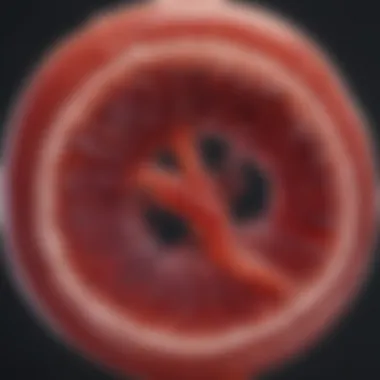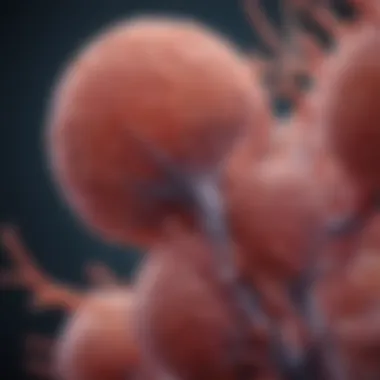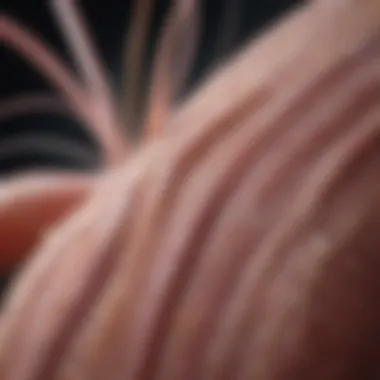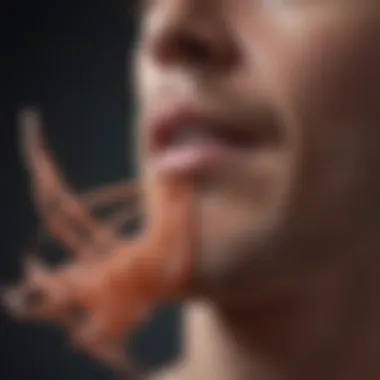Exploring the Vital Role of Cord Tissue in Medicine


Intro
Cord tissue may not get the spotlight that cord blood does, but it holds a wealth of potential waiting to be explored. This biological material, found in the umbilical cord, serves much more than just a bridge between mother and child. Understanding cord tissue is crucial because it encompasses essential components, such as Wharton's jelly and mesenchymal stem cells, which have shown promising capabilities in medical advancements. This article aims to unpack the intricacies of cord tissue, looking closely at its makeup, its role in health management, and its potential in regenerative medicine.
Research Overview
Summary of Key Findings
Research into cord tissue reveals a multifaceted landscape. Here are some of the major findings that come through:
- Wharton's Jelly: This gelatinous substance is packed with unique properties that support stem cell growth and differentiate into various cell types.
- Stem Cell Potential: Mesenchymal stem cells from cord tissue offer new hope for treating conditions like degenerative diseases and injuries, showcasing their adaptive capabilities.
- Regenerative Applications: The versatility of cord tissue opens doors to innovation in therapies, where its components are used for tissue engineering and organ repair.
"Cord tissue is like an unsung hero of neonatal healthcare—vastly important yet frequently overlooked."
Importance of the Research
Understanding cord tissue is critical not only for its potential applications but also for fostering advancements in medical treatments. This research informs healthcare professionals about alternative sources to harvest stem cells, reducing reliance on more invasive methods. Furthermore, it helps in shaping future policies around bioethics and public health initiatives. As the landscape of medical science continues to evolve, knowledge of this resource could play a pivotal role in patient care and health innovation.
Methodology
Research findings on cord tissue derived from systematic reviews and clinical studies, utilizing sound methodologies to gather and analyze data.
Study Design
- Observational Studies: Most studies have focused on the natural properties of cord tissue without intervention, allowing for thorough documentation of real-world characteristics.
- Clinical Trials: Emerging studies are testing the efficacy of cord tissue-based therapies in patients with various conditions, comparing outcomes with conventional treatments.
Data Collection Techniques
- Biopsy Samples: Samples from umbilical cords were collected and subjected to various analyses to evaluate their cellular components and growth capabilities.
- Cohort Studies: Researchers have followed specific patient groups, observing outcomes related to treatments utilizing cord tissue-derived cells. This ongoing research feeds back into understanding the effectiveness of therapies.
As we delve deeper into the subsequent sections, this exploration will focus on distinct aspects, illustrating the potential of cord tissue in shaping the future of regenerative medicine.
Prelude to Cord Tissue
Cord tissue is a fascinating topic that deserves more attention in medical discussions. While many folks know about cord blood, cord tissue and its role in health and regenerative medicine is often left in the shadows. Understanding cord tissue opens up a treasure trove of possibilities in medicine, making it a vital area for anyone invested in advancing healthcare.
As we dive into this section, we'll explore various elements of cord tissue, its components, and why they matter in the broader context of medical applications. The distinct characteristics of cord tissue, such as its rich supply of mesenchymal stem cells, set it apart as a robust resource for regeneration and therapy. This information is crucial not only for researchers but also for practitioners looking to expand treatment options.
"Cord tissue can be a game-changer in regenerative medicine. Understanding it is key to unlocking new potentials."
Defining Cord Tissue
Cord tissue refers to the biological material that is attached to the placenta and connects the developing fetus to the maternal blood supply via the umbilical cord. It includes various components like Wharton's jelly, blood vessels, and cells that serve significant functions during pregnancy and may hold therapeutic potentials postpartum. Unlike cord blood, which is widely recognized for its role in saving lives through transplant, cord tissue is often overlooked despite its rich cellular nature.
Awareness of the proper definitions and structures involved in cord tissue is paramount. To fully appreciate its applications and significance in medical procedures, one must grasp what precisely constitutes cord tissue. Researchers are particularly interested in the regenerative capabilities of the stem cells found within, which can potentially treat several conditions, including degenerative diseases.
Historical Background
The concept of using umbilical cord tissue for medical purposes isn't exactly new, but it hasn't always been at the forefront like its counterpart, cord blood. Initially, most studies centered on cord blood harvesting, leading to remarkable breakthroughs in hematopoietic stem cell therapy. As the medical community continued to explore the roles of stem cells, interest shifted towards the potential of cord tissues.
In the early 2000s, pioneering research highlighted how mesenchymal stem cells derived from cord tissue could differentiate into various cell types. This marked a turning point in how we view cord tissue, suggesting that it could be just as critical for regenerative medicine as cord blood. Key historical studies have reflected the changing landscape, showing a trend toward recognizing the broader spectrum of applications that cord tissue may offer.
Overall, the understanding of cord tissue and its historical progression sheds light on its growing importance, urging exploration into how it can further enhance healthcare outcomes.


Components of Cord Tissue
Cord tissue is like an unsung hero in the realm of medical science. Often sidelined when the conversation revolves around umbilical cord blood, the components of cord tissue hold significant promise in advancing healthcare. Understanding these elements is key for researchers, healthcare professionals, and even expectant parents considering the benefits of cord tissue banking.
Wharton's Jelly
Wharton's jelly is the gelatinous substance found in the umbilical cord and is rich in extracellular matrix substances. This magical jelly acts as a protective cushion for the umbilical vessels, preventing compression and ensuring a steady supply of nutrients and oxygen to the developing fetus. Beyond its protective role, Wharton's jelly contains a myriad of bioactive molecules, such as glycosaminoglycans and proteins, that have been shown to aid in wound healing and inflammation reduction.
Researchers are turning to Wharton's jelly for its potential applications in regenerative medicine. The basic structure is not only an impressive shock absorber but also serves as a source for mesenchymal stem cells, which have the ability to differentiate into various cell types. Thus, understanding Wharton's jelly is paramount, as its components may be repurposed to support tissue repair and cellular regeneration in a postnatal setting.
Umbilical Vein and Arteries
The umbilical cord consists of one vein and two arteries, each with distinct functions that are fundamental to fetal development. The umbilical vein transports oxygen-rich blood from the placenta to the fetus, while the two arteries return deoxygenated blood back to the placenta. This remarkable system facilitates the exchange of nutrients and waste, essentially keeping the developing child healthy and thriving.
What is often overlooked is the potential of these vessels in medical applications. After childbirth, umbilical veins can be harvested for their endothelial cells, which have valuable properties for vascular research and potential therapies for vascular diseases. The arteries, conversely, offer insights into blood vessel health and may even contribute to innovations in vascular grafting. Their dual purpose—supporting both fetal nourishment and serving as a resource for medical applications—demonstrates the comprehensive importance of these vessels in the broader spectrum of healthcare.
Mesenchymal Stem Cells
Among the standout components of cord tissue are mesenchymal stem cells, often referred to as MSCs. These cells are unique due to their ability to differentiate into a variety of cell types, including bone, cartilage, and fat cells. They are found throughout the cord tissue, particularly in Wharton's jelly.
One of the most appealing characteristics of MSCs is their immunomodulatory effects. They can help regulate the immune system, which is crucial not only during development but also for treating conditions like autoimmune diseases. There’s a growing body of literature supporting their therapeutic uses, such as in the treatment of orthopedic injuries and even in combating certain cancers. As research unfolds, MSCs from cord tissue may emerge as pivotal elements in tailored regenerative therapies.
Epithelial Cells
Epithelial cells are another crucial aspect of cord tissue. They line the surfaces of the umbilical cord and have a role that extends beyond merely acting as barriers. These cells play a key part in the production of various proteins crucial for fetal development. Additionally, they exhibit properties that help in the protection against infection and inflammation during pregnancy.
The therapeutic potential of epithelial cells from cord tissue is still under exploration. Their regenerative capabilities may lead to advances in treating skin conditions or even aiding in organ repair. The practical considerations cannot be overlooked as well—these cells are relatively easy to isolate and expand in culture, making them suitable candidates for use in laboratory settings or for potential clinical applications.
"The exploration of the components of cord tissue is like unearthing hidden treasures within the realm of regenerative medicine."
In summary, each of these components contributes significantly to the biological and therapeutic landscape of cord tissue. From the protective nature of Wharton's jelly to the multifaceted roles of the umbilical vein and arteries, mesenchymal stem cells, and epithelial cells, the importance of understanding these elements cannot be overstated. Their implications extend well beyond fetal development, promising exciting avenues for research and medical applications that could change lives.
Biological Significance of Cord Tissue
The biological significance of cord tissue is a compelling area of study, brimming with potential for both understanding and application in medicine. As research unfolds, we are beginning to appreciate how cord tissue is not merely a remnant of birth, but rather a treasure trove of cellular components essential for development and repair. Recognizing the biological significance of cord tissue provides insight into its diverse roles in human health.
Role in Development
Cord tissue plays a pivotal role during the developmental phase of a human being. It serves as a lifeline, not just for transport but also for constructing the very framework of a healthy biological system. The various cells contained within the tissue, such as mesenchymal stem cells, support tissue growth and differentiation. For instance, these cells can develop into cartilage, bone, and fat cells, influencing everything from skeletal formation to energy storage.
Consider this: a fetus, drawing nutrients and oxygen through the umbilical cord, benefits from the unique properties found in cord tissue, which assist in cellular signaling and organ development. The initial growth and maturation process relies heavily on these interactions—without them, the harmony of development may be disrupted.
- Nutrient Transport:
- Cell Signaling:
- Vital for fetal development.
- Provides necessary elements for growth.
- Influences the behavior of surrounding cells through molecular interactions.
- Encourages proper differentiation.
Thus, the biological significance here cannot be overstated; cord tissue is not just important—it is integral to the foundational stages of life itself.
Immune System Modulation
Cord tissue is recognized for its immunomodulatory characteristics, which play an essential role in maintaining immune homeostasis. This is quite interesting since it hints at why cord tissue-derived cells are being explored for therapeutic applications, such as in transplant medicine. The tissue comprises a unique arrangement of cells that can help attenuate immune responses. This property is essential particularly in cases where an auto-immune reaction is detrimental or when organ transplants are considered.
"The immunological profile of cord tissue is remarkable, possibly paving the way for breakthroughs in treating chronic conditions and managing allergies."


Research illustrates that mesenchymal stem cells from cord tissue possess a capacity to regulate immune cell activities, dampening inflammation and promoting tissue healing. This immune modulation can:
- Reduce inflammation:
- Support graft survival:
- Facilitate tissue repair:
- Helps in conditions like rheumatoid arthritis, where inflammation is rampant.
- Aids organ transplants by lowering rejection rates.
- Promotes healing in damaged tissues.
In summary, these functions highlight how cord tissue could change the landscape of therapeutic approaches concerning immune-related diseases.
Cell Regeneration and Repair
The regenerative capabilities of cord tissue have attracted tremendous interest, especially in the context of regenerative medicine. Cells found in cord tissue, especially mesenchymal stem cells, are regarded as a double-edged sword; they not only repair damaged tissues but also potentially restore functionality lost due to diseases or injuries.
This regenerative potential is particularly notable in conditions such as:
- Degenerative diseases like spinal cord injuries.
- Acute injuries like heart attacks that can benefit from cell infusion therapies.
- Chronic conditions such as Multiple Sclerosis.
The ability of cord tissue-derived cells to secrete growth factors further enhances the healing processes, stimulating not just repair but also regeneration of previously compromised tissues. This could lead to therapies that not only better manage symptoms but also address the root causes of damage.
Applications of Cord Tissue in Medicine
Exploring the applications of cord tissue in medicine is like opening a treasure chest of opportunities. This remarkable material, often sitting in the shadow of its more famous sibling, cord blood, carries significant potential for therapeutic use. As we dissect this section, we will not only highlight specific elements of how cord tissue is utilized but also address the benefits and important considerations associated with its application in modern medicine.
Regenerative Medicine
Regenerative medicine has become a hot topic in medical science. Here, cord tissue plays an instrumental role. It is a rich source of mesenchymal stem cells and factors that support cell renewal and tissue repair, offering promising avenues for treating various conditions. Researchers are investigating how these stem cells can regenerate damaged tissues in the body, particularly in conditions like heart disease or spinal cord injuries.
By leveraging the cells derived from cord tissue, scientists aim to create strategies that not only replace what was lost but rejuvenate the surrounding tissue. The benefits of using cord tissue in regenerative medicine extend beyond mere repair. Potential applications include:
- Healing of chronic wounds: The properties of cord tissue make it ideal for promoting healing in difficult cases.
- Cartilage regeneration: The chance to repair joints affected by degenerative diseases is a game changer.
- Cardiac recovery: Using cells from cord tissue might help restore function after heart-related issues.
Diseases Treated
The range of diseases that might benefit from cord tissue treatment is quite extensive. As research continues to unfold, several conditions are emerging as primary targets. Some examples include:
- Hematological disorders: Diseases like leukemia, where traditional treatments can take a toll on the body, could potentially be treated more effectively with therapies derived from cord tissue.
- Autoimmune diseases: Conditions such as lupus or rheumatoid arthritis may see improvements in treatment regimens through the use of cellular therapies from cord tissue.
- Neurological disorders: Innovative approaches utilizing these cells are being explored for diseases like Parkinson's and multiple sclerosis, hinting at new options where hope was once scant.
The versatility of these applications aligns well with the rising demand for personalized medicine, aiming at tailored treatment that suits individual patients better.
Tissue Engineering
Tissue engineering is an innovative field paving the way for future medical solutions. In this arena, cord tissue shows bold promise. By crafting biological substitutes that mimic natural tissues, researchers are leaning on cord-derived materials to develop functional tissue replacements. The Wharton's jelly within cord tissue holds significant promise, as it can be molded into diverse structures to repair or replace damaged tissues.
The process typically involves:
- Harvesting the cells and materials from cord tissue.
- Cultivating these in controlled environments to encourage the development of new, functional tissues.
- Implantation of these engineered tissues back into the patient to promote healing and restoration.
The applications of tissue engineering extend to areas such as:
- Skin grafts for burn victims
- Bone constructs for fracture repair
- Vascular grafts to improve blood flow in patients with cardiovascular issues
"Cord tissue is more than just a byproduct of birth; it holds the potential to revolutionize how we approach healing and disease treatment."


In summary, the applications of cord tissue in medicine signify a critical frontier in both research and clinical practice. The future looks promising, and as more is discovered about its capabilities, we might witness transformative changes in the landscape of healthcare.
Research Developments
Research into cord tissue is a continually evolving field, holding great promise for future medical innovations. As healthcare professionals, researchers, and medical scientists delve deeper into the potential of this unique tissue, they uncover new tools for treatment, particularly in areas involving tissue regeneration and transplant medicine. From its components, like mesenchymal stem cells found in cord tissue, to its broader implications in regenerative therapies, the importance of these developments cannot be overstated.
Current Studies
Currently, a number of studies are taking place worldwide, focusing on a variety of dimensions of cord tissue research. For instance, investigations are underway examining how mesenchymal stem cells derived from cord tissue can assist in repairing various types of damaged tissue. Some scientists highlight their potential in reducing inflammation and promoting healing within cardiac tissues after a myocardial infarction.
Moreover, researchers are evaluating the role of Wharton's jelly in supporting the structure of the cells and its effect on the regenerative capabilities of stem cells. Recent findings suggest that the jelly contains several growth factors that may facilitate better homing of stem cells to areas needing repair. This could make it a vital player in future therapies aimed at treating degenerative diseases, such as diabetes and multiple sclerosis.
Some studies have even begun looking at the long-term storage of cord tissue and its implications for future health. Being able to preserve these tissues effectively could lead to breakthroughs in personalized medical treatments, thus providing a safety net for patients needing stem cell therapies later in life.
Future Directions
Looking ahead, the direction research takes could dramatically change the landscape of regenerative medicine. Experts predict a surge in clinical trials aimed at understanding the full potential of cord tissue treatments. Researchers may focus more on its application in personalized medicine, where individual genetic markers guide treatment plans leveraging stem cells.
There is also growing interest in combining cord tissue-derived cells with advanced technologies such as 3D bioprinting and gene editing. Imagine the possibilities: creating custom tissues synthetically via bioprinting, or correcting genetic defects in stem cells derived from cord tissue using CRISPR technology, paving the way for next-generation therapies.
Moreover, the insights gained from ongoing research will steer discussions on ethical considerations, especially concerning the consent process for using cord tissue in clinical settings. Understanding these perspectives is as crucial as the scientific gains, impacting transparency and trust within the community.
"The future of cord tissue research holds potential for innovations previously thought to be science fiction, expanding the horizons of possible treatments."
The road ahead is ripe with prospects, but navigating this landscape will require a careful balancing act between innovation and ethical responsibility. As scientists and practitioners continue to unravel the depths of cord tissue, the implications for healthcare are both significant and profound.
Ethical Considerations
The conversation surrounding cord tissue is not merely about its scientific and medical potential; it also encompasses a realm of ethical considerations that must not be overlooked. These considerations play a pivotal role in the acceptance and practical application of cord tissue in modern medicine. Ensuring that the rights and dignity of donors are respected forms the backbone of ethical practice, balancing innovation with responsibility.
Informed Consent
Informed consent is critical when discussing biological materials, especially those derived from newborns. Parents are expected to make educated decisions regarding the donation of cord tissue, and this process involves an intricate dance of communication and transparency.
- Transparency in procedures and potential uses of donated tissue is essential. Parents should receive clear information about how their baby’s cord tissue will be collected, processed, and used in future applications. This avoids any misunderstandings and fosters trust in the healthcare system.
- Comprehension of the risks and benefits is equally vital. Parents must grasp not only the advantages of using cord tissue, such as its regenerative properties, but also any possible implications for their child’s future health. To ensure that parents are fully informed, healthcare providers must present this information in an approachable manner, avoiding complex medical jargon that may create barriers to understanding.
- Finally, it's crucial for healthcare professionals to respect parents’ decisions, whether or not they choose to donate. Building a supportive environment where parents feel comfortable asking questions and voicing concerns can lead to more ethical practices surrounding donation.
Storage and Use of Cord Tissue
Following informed consent, the ethical considerations persist concerning the methods of storage and subsequent use of cord tissue. Here are some focal points to reflect upon:
- Regulation of Storage Facilities: Cord tissue storage facilities should adhere to strict regulations to maintain high safety and quality standards. Parents should research and understand the facility’s accreditation and operational practices. Recognizing that not all storage facilities are created equal is fundamental in ensuring the safety of the biological material.
- Potential for Commercialization: The commercialization of cord tissue is another concern. Although the use of cord tissue for treatments can transform healthcare, the potential for profit-driven motives raises questions about ethical practices. There ought to be a commitment to prioritize patients’ well-being over financial gain.
- Future Uses of Cord Tissue: The landscape of medical research is ever-evolving, and as new applications for cord tissue emerge, should there be limitations placed on how the tissue may be used? Making provisions for its usage in research without compromising ethical standards is a balancing act that researchers must navigate closely.
"Balancing innovation with ethical responsibility is crucial in the evolving landscape of medical science."
Closure
The conclusion of this article serves as a bridge, linking various discussions about cord tissue to a broader context within medical research and practice. As we delve deeper into the exploration of cord tissue and its myriad components, we uncover a treasure trove of potential applications that extend far beyond traditional immunology or regenerative medicine.
Summary of Findings
In summary, our analysis has thoroughly examined the essential aspects of cord tissue. Key findings include:
- Defining Cord Tissue: It is a vital component, often overlooked, that houses several crucial elements like mesenchymal stem cells and Wharton's Jelly.
- Biological Significance: Cord tissue plays an indispensable role during development and exhibits impressive capacities for regeneration and repair in various medical contexts.
- Applications: The multifaceted uses of cord tissue in regenerative medicine are noteworthy, from treatments in serious health conditions to ongoing advancements in tissue engineering.
- Ethical Considerations: Engaging responsibly with cord tissue also requires careful navigation of ethical waters, especially concerning informed consent and responsible storage.
Through these insights, cord tissue is not merely a byproduct; it is an invaluable resource within the healthcare domain. We have illustrated that proper understanding and utilization could pave the way for novel therapies and approaches that enhance patient outcomes, human health, and the very landscape of medical science.
Implications for Future Research
Looking forward, the implications for future research in the realm of cord tissue are profound. As we stand on the cusp of scientific advancements, the door is ajar for several potential areas of inquiry, including:
- Innovative Treatment Protocols: By harnessing the biological properties of cord tissue, novel therapies for degenerative diseases and injuries are ripe for exploration. This includes refining methods for stem cell extraction and application protocols.
- Long-term Storage Solutions: Developing strategies that focus on the long-term viability of cord tissue could significantly impact how we utilize these resources in the years to come.
- Ethical Frameworks: As research continues to advance, establishing clearer ethical guidelines will be imperative. This ensures not only compliance but also public trust in medical practices involving cord tissue.



